Cottontail rabbit
Cottontail rabbits are among the 20 lagomorph species in the genus Sylvilagus, found in the Americas.[1] Most Sylvilagus species have stub tails with white undersides that show when they retreat, giving them their characteristic name. However, this feature is not present in all cottontails nor is it unique to the genus.
| Cottontail rabbits[1] | |
|---|---|
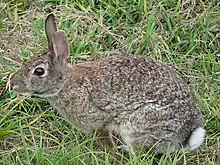 | |
| Eastern cottontail rabbit (Sylvìlagus floridanus) | |
| Scientific classification | |
| Kingdom: | Animalia |
| Phylum: | Chordata |
| Class: | Mammalia |
| Order: | Lagomorpha |
| Family: | Leporidae |
| Genus: | Sylvilagus Gray, 1867 |
| Type species | |
| Lepus sylvaticus | |
| Species | |
|
20, see text | |
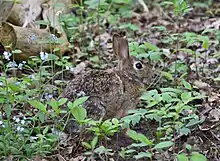
The genus is widely distributed across North America, Central America and northern and central South America, though most species are confined to particular regions. Most (though not all) species live in nests called forms, and all have altricial young. An adult female averages three litters per year, which can occur in any season; occurrence, and litter size depend on several factors including time of the year, weather, and location. The average litter size is four but can range from as few as two to as many as eight, most of whom do not go on to survive to adulthood.
Cottontail rabbits show a greater resistance to myxomatosis than European rabbits.[2]
Evolution
The cottontail is one of several species of Sylvilagus; their closest relative is Brachylagus, the pygmy rabbit. They are more distantly related to the European and other rabbits, and more distantly still to the hares. The cladogram is based on mitochondrial gene analysis.[3][4]
| Cottontails |
| |||||||||||||||||||||||||||||||||||||||||||||||||||||||||||||||
Lifespan
The lifespan of a cottontail averages about two years, depending on the location. Almost every living carnivorous creature comparable to or larger in size than these lagomorphs is a potential predator, including such diverse creatures as domestic dogs, cats, humans, snakes, coyotes, mountain lions, foxes, and if the cottontail is showing signs of illness, even squirrels. The cottontail's most frequent predators are various birds of prey. Cottontails can also be parasitized by botfly species including Cuterebra fontinella.[5] Newborn cottontails are particularly vulnerable to these attacks. Cottontails use burrows vacated by other animals, and the burrows are used for long enough periods that predators can learn where the cottontails reside and repeatedly return to predate the lagomorphs. Though cottontails are prolific animals that can have multiple litters in a year, few of the resulting offspring survive to adulthood. Those that do grow very quickly and are full grown adults at three months.[6]
Eating mechanics
In contrast to rodents, (squirrels, etc.) which generally sit on their hind legs and hold food with their front paws while feeding; cottontail rabbits eat while on all fours. Cottontail rabbits typically only use their nose to move and adjust the position of the food that it places directly in front of its front paws on the ground. The cottontail will turn the food with its nose to find the cleanest part of the vegetation (free of sand and inedible parts) to begin its meal. The only time a cottontail uses its front paws while feeding is when vegetation is above its head on a living plant, at which point the cottontail will lift its paw to bend the branch to bring the food within reach.[7]
Cottontails are rarely found out of their burrows looking for food on windy days, because the wind interferes with their hearing capabilities. Hearing an incoming predator before they get close enough to attack is their primary defense mechanism.[8]
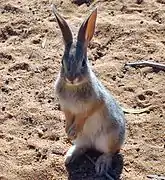 Juvenile cottontail standing in anticipation of food
Juvenile cottontail standing in anticipation of food Cottontails are very sociable animals within their peer group
Cottontails are very sociable animals within their peer group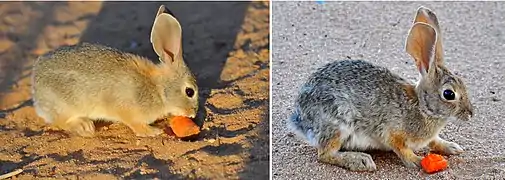 Male desert cottontail at 8 weeks, and the same cottontail at 16 months of age
Male desert cottontail at 8 weeks, and the same cottontail at 16 months of age
Species
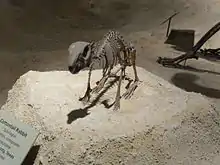
The subgenera were described in the 19th century based on limited morphological data that have been shown to not be of great use, nor to depict phylogenetic relationships. Molecular studies (limited in scope to the mitochondrial 12S gene) have shown that the currently accepted subgeneric structure,[1] while of some heuristic value, is unlikely to withstand additional scrutiny.[9]
| Subgenus | Image | Common name | Scientific name | Distribution |
|---|---|---|---|---|
| Microlagus | 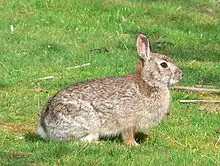 |
Brush rabbit | Sylvilagus bachmani | West coast of North America, from the Columbia River in Oregon to the southern tip of the Baja California Peninsula. |
| San Jose brush rabbit | Sylvilagus mansuetus | San José Island in the Gulf of California | ||
| Sylvilagus |  |
Desert cottontail | Sylvilagus audubonii | Western United States from eastern Montana to western Texas, and in Northern and Central Mexico |
| Manzano Mountain cottontail | Sylvilagus cognatus | Manzano Mountains in New Mexico, United States | ||
| Mexican cottontail | Sylvilagus cunicularius | Mexico from the state of Sinaloa to the states of Oaxaca and Veracruz | ||
 |
Eastern cottontail | Sylvilagus floridanus | eastern and south-central United States, southern Canada, eastern Mexico, Central America and northernmost South America. | |
| Tres Marias rabbit | Sylvilagus graysoni | Tres Marias Islands, Mexico | ||
.jpg.webp) |
Mountain cottontail | Sylvilagus nuttallii | Intermountain west of Canada and the United States. | |
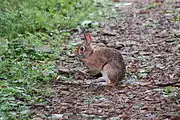 |
Appalachian cottontail or Allegheny cottontail | Sylvilagus obscurus | eastern United States. | |
| Davis Mountains cottontail | Sylvilagus robustus | southwestern United States and adjacent Mexico | ||
 |
New England cottontail | Sylvilagus transitionalis | New England, specifically from southern Maine to southern New York. | |
| Tapeti | Andean cottontail | Sylvilagus andinus | Ecuador | |
.jpg.webp) |
Swamp rabbit | Sylvilagus aquaticus | southern United States. | |
 |
Tapeti | Sylvilagus brasiliensis | southern Mexico to northern Argentina. | |
| Dice's cottontail | Sylvilagus dicei | Costa Rica and Panama | ||
| Omilteme cottontail | Sylvilagus insonus | Guerrero, Mexico | ||
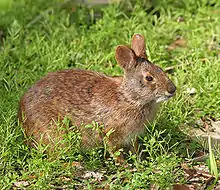 |
Marsh rabbit | Sylvilagus palustris | southern Florida | |
| Suriname lowland forest cottontail | Sylvilagus parentum | western Suriname | ||
| Rio de Janeiro dwarf cottontail | Sylvilagus tapetillus | Rio de Janeiro, Brazil | ||
| Venezuelan lowland rabbit | Sylvilagus varynaensis | western Venezuela | ||
References
- Hoffman, R.S.; Smith, A.T. (2005). "Genus Sylvilagus". In Wilson, D.E.; Reeder, D.M (eds.). Mammal Species of the World: A Taxonomic and Geographic Reference (3rd ed.). Johns Hopkins University Press. pp. 207–211. ISBN 978-0-8018-8221-0. OCLC 62265494.
- Carter, G.R.; Wise, D.J. (2006). "Poxviridae". A Concise Review of Veterinary Virology. Retrieved 2006-06-13.
- Ruedas, Luis A.; Marques Silva, Sofia; et al. (October 2019). "Taxonomy of the Sylvilagus brasiliensis complex in Central and South America (Lagomorpha: Leporidae)". Journal of Mammalogy. 100 (5): 1599–1630. doi:10.1093/jmammal/gyz126. S2CID 202855918.
- Kraatz, Brian P.; et al. (2015). "Ecological correlates to cranial morphology in Leporids (Mammalia, Lagomorpha)". PeerJ. 3: e844. doi:10.7717/peerj.844. PMC 4369340. PMID 25802812.
- Jennison CA, Rodas LR, Barrett GW (2006). "Cuterebra fontinella parasitism on Peromyscus leucopus and Ochrotomys nuttalli". Southeastern Naturalist. 5 (1): 157–168. doi:10.1656/1528-7092(2006)5[157:CFPOPL]2.0.CO;2.
- "Sylvilagus floridanus". Retrieved 28 June 2017.
- "Small mammals" (PDF).
- "Rabbits and Hares".
- Ruedas LA, Silva SM, French JM, Platt II RN, Salazar-Bravo J, Mora JM, Thompson CW (February 9, 2017). "A prolegomenon to the systematics of South American cottontail rabbits (Mammalia, Lagomorpha, Leporidae: Sylvilagus): designation of a neotype for S. brasiliensis (Linnaeus, 1758), and restoration of S. andinus (Thomas, 1897) and S. tapetillus Thomas, 1913". Miscellaneous Publications. Ann Arbor: Museum of Zoology, University of Michigan (205): i–iv, 1–67. hdl:2027.42/136089. ISSN 0076-8405.